- Region
- Águilas
- Alhama de Murcia
- Jumilla
- Lorca
- Los Alcázares
- Mazarrón
- San Javier
-
ALL AREAS & TOWNS
- AREAS
- SOUTH WEST
- MAR MENOR
- MURCIA CITY & CENTRAL
- NORTH & NORTH WEST
- TOWNS
- Abanilla
- Abarán
- Aguilas
- Alamillo
- Alcantarilla
- Aledo
- Alhama de Murcia
- Archena
- Balsicas
- Blanca
- Bolnuevo
- Bullas
- Cañadas del Romero
- Cabo de Palos
- Calasparra
- Camping Bolnuevo
- Campo De Ricote
- Camposol
- Canada De La Lena
- Caravaca de la Cruz
- Cartagena
- Cehegin
- Ceuti
- Cieza
- Condado de Alhama
- Corvera
- Costa Cálida
- Cuevas De Almanzora
- Cuevas de Reyllo
- El Carmoli
- El Mojon
- El Molino (Puerto Lumbreras)
- El Pareton / Cantareros
- El Raso
- El Valle Golf Resort
- Fortuna
- Fuente Alamo
- Hacienda del Alamo Golf Resort
- Hacienda Riquelme Golf Resort
- Isla Plana
- Islas Menores & Mar de Cristal
- Jumilla
- La Azohia
- La Charca
- La Manga Club
- La Manga del Mar Menor
- La Pinilla
- La Puebla
- La Torre
- La Torre Golf Resort
- La Unión
- Las Palas
- Las Ramblas
- Las Ramblas Golf
- Las Torres de Cotillas
- Leiva
- Librilla
- Lo Pagan
- Lo Santiago
- Lorca
- Lorquí
- Los Alcázares
- Los Balcones
- Los Belones
- Los Canovas
- Los Nietos
- Los Perez (Tallante)
- Los Urrutias
- Los Ventorrillos
- Mar De Cristal
- Mar Menor
- Mar Menor Golf Resort
- Mazarrón
- Mazarrón Country Club
- Molina de Segura
- Moratalla
- Mula
- Murcia City
- Murcia Property
- Pareton
- Peraleja Golf Resort
- Perin
- Pilar de la Horadada
- Pinar de Campoverde
- Pinoso
- Playa Honda
- Playa Honda / Playa Paraíso
- Pliego
- Portmán
- Pozo Estrecho
- Puerto de Mazarrón
- Puerto Lumbreras
- Puntas De Calnegre
- Region of Murcia
- Ricote
- Roda Golf Resort
- Roldan
- Roldan and Lo Ferro
- San Javier
- San Pedro del Pinatar
- Santiago de la Ribera
- Sierra Espuña
- Sucina
- Tallante
- Terrazas de la Torre Golf Resort
- Torre Pacheco
- Totana
- What's On Weekly Bulletin
- Yecla


- EDITIONS:
 Spanish News Today
Spanish News Today
 Alicante Today
Alicante Today
 Andalucia Today
Andalucia Today
ARQUA, Marine Archaeology Museum, Cartagena
Cartagena, ARQUA, Museo Nacional de Arqueologia Subacuatica.
Located in the Paseo del Muelle Alfonso XII, next to the cruise ship terminal, this museum has been designed as a window into the world of underwater archaeology, the cutting edge building housing not only museum space but also storage, restoration and research facilities, in its role as the Spanish national centre for marine archaeology.

The Region of Murcia possesses a rich marine heritage, due for the main part, to the long history of Cartagena itself as a trading port, and important focal point of military naval activity. The whole of the Mediterranean basin provided a natural trade route for traders linking into Africa and the Middle East as well  as throughout the Mediterranean nations, allied to which was the natural abundance of raw materials within the Iberian peninsula: mineral ores, esparto grass, marble, shellfish which could be used to make dyes and of course, abundance of fish to make into sauces, all attracted the attention of the Phoenicians, Greeks, Romans and Carthaginians
as throughout the Mediterranean nations, allied to which was the natural abundance of raw materials within the Iberian peninsula: mineral ores, esparto grass, marble, shellfish which could be used to make dyes and of course, abundance of fish to make into sauces, all attracted the attention of the Phoenicians, Greeks, Romans and Carthaginians
Cartagena and the other trading sites located along the Murcian coastline, including Águilas, Puerto de Mazarrón and San Javier hold some important wrecks, including two Phoenician shore boats discovered at 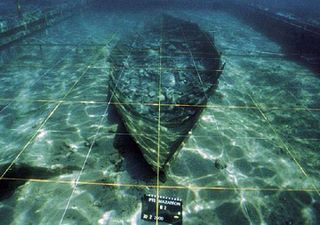 Mazarrón, one of which was intact, and the most recent find, an even larger Phoenician vessel at La Manga, the Bajo de la Campana site, which is currently undergoing excavation.
Mazarrón, one of which was intact, and the most recent find, an even larger Phoenician vessel at La Manga, the Bajo de la Campana site, which is currently undergoing excavation.
There are also a substantial number of Roman wrecks, and many more modern sites, relating to the important role played by Cartagena in Mediterranean military history.
This museum holds an impressive collection of artefacts recovered from sites in the region, and also acts as an educational facility, teaching visitors about the processes of marine archaeology, the techniques employed to locate, map and excavate an underwater site, as well as the technology used to catalogue, conserve or 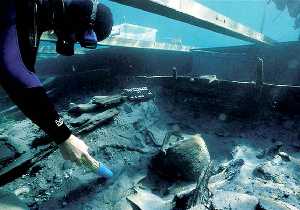 restore the remains recovered during the archaeological process.
restore the remains recovered during the archaeological process.
Its an interesting museum to visit, and at first glance it appears to contain very little, but in fact holds a large range of interesting interactive displays, so start pressing buttons and a fascinating world of legends, superstition, boat building and navigation emerges.
Theres also a laboratory area which can occupy the youngsters for ages, models which give a clear idea of how the port area would have appeared over 2000 years ago, and exhibits recovered from sunken vessels showing lead ingots mined from the hills surrounding the city, and ivory tusks which were highly prized in the 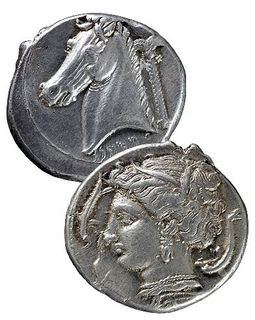 days when Hannibal, the famous general who took his army and his elephants across the Alps, lived here in Cartagena.
days when Hannibal, the famous general who took his army and his elephants across the Alps, lived here in Cartagena.
There are intimate glimpses of daily life, a little terracotta bottle, believed to have been used as a babies bottle, coins from Carthage, the great city founded by the Carthaginians who occupied this area, and whose story is celebrated every year in the Romans and Carthaginians Fiestas which take place in the autumn. One coin from this era shows the head of the goddess Tanit, to whom offerings are made in the fiestas, and many of the other pieces breathe life into the past, bringing it closer and helping to engender a little understanding of the evolution of Cartagena.
 Other more modern exhibits look at the life of a sailor on board, the 200 year old clay pipe bowls for example, showing a sailing ship in full sail, but visitors could easily miss the significance of the three flowers decorating the second bowl, failing to see that although they look like thistles, that theyre actually poppies, the source of opium, the relaxant of many a sailor throughout history and one of the most fought over substances on the planet.
Other more modern exhibits look at the life of a sailor on board, the 200 year old clay pipe bowls for example, showing a sailing ship in full sail, but visitors could easily miss the significance of the three flowers decorating the second bowl, failing to see that although they look like thistles, that theyre actually poppies, the source of opium, the relaxant of many a sailor throughout history and one of the most fought over substances on the planet.
The museum is also the home of the prized Phoenician boat, Mazarrón 1, the remains of which are actually located in the museum, together with a replica of Mazarrón 2, which is still enterred in the sand beneath the waters of the bay where it sank, 2600 years ago, now protected beneath a case of steel to prevent it being damaged by the curious or the careless.
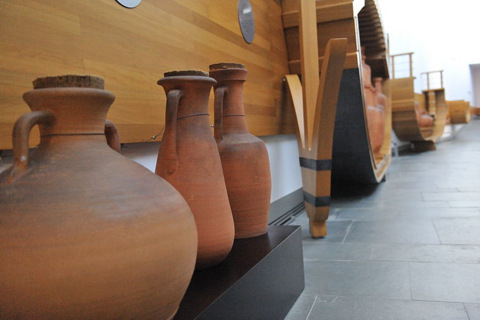 Many of the artefacts, including, incredibly, wood which was used to pack the cargo of lead ore ingots survived in a remarkable state of preservation and are on show in the museum, together with amphorae from Mazarrón 1 which were believed to have been carrying food products, some of them the garum fish paste which was manufactured in Mazarron, in the salt fish factory which is open to the public following its excavation.
Many of the artefacts, including, incredibly, wood which was used to pack the cargo of lead ore ingots survived in a remarkable state of preservation and are on show in the museum, together with amphorae from Mazarrón 1 which were believed to have been carrying food products, some of them the garum fish paste which was manufactured in Mazarron, in the salt fish factory which is open to the public following its excavation.
Coinage of Nuestra Señora de la Mercedes
The Museum also houses a new display relating to the treasure of Nuestra Señora de la Mercedes, a vast 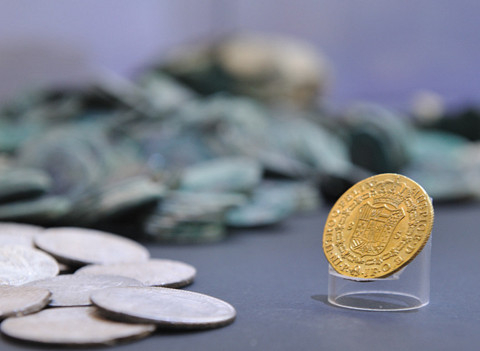 haul of coinage recovered by American treasure hunter, Odyssey. ( Click treasure of Nuestra Señora de la Mercedes for full information.)
haul of coinage recovered by American treasure hunter, Odyssey. ( Click treasure of Nuestra Señora de la Mercedes for full information.)
Just before Christmas 2012, Cartagena became the final destination for 574,553 pieces of gold and silver coinage, weighing 14.5 tons, and with an estimated value of 500 million dollars, the treasure recovered from the sunken Spanish frigate, Nuestra Señora de la Mercedes.
Sunk by British ships in 1804, the vessel had been laden with coinage destined to pay for Spain´s wars in Europe. 200 years after sinking, the vessel was located by American marine salvage company Odyssey, and became the subject of an acrimonious court battle which was eventually won by the Spanish government, and the coinage was returned intact to Spain.
The ARQUA has the specialist knowledge, and the laboratory facilities, to cope with the enormous task of 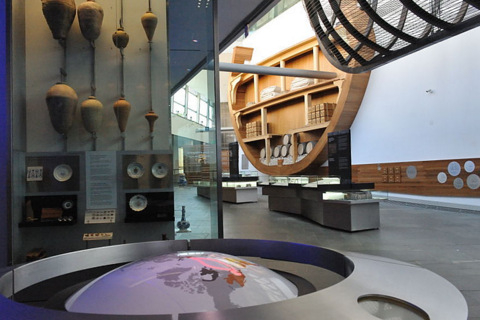 restoring and preserving this vast haul of coins for generations to come, and technicians from the museum are engaged in the onerous task of separating the great lumps of coins which are fused together to clean and conserve them. Part of the coinage is on show in Madrid and the ARQUA itself has 8.000 pieces in a central exhibition.
restoring and preserving this vast haul of coins for generations to come, and technicians from the museum are engaged in the onerous task of separating the great lumps of coins which are fused together to clean and conserve them. Part of the coinage is on show in Madrid and the ARQUA itself has 8.000 pieces in a central exhibition.
This includes a replica cut through segment showing how the vessel was loaded, an interactive map analysing the trade routes in operation when the vessel sank, a display analysing the navigation methods used during this era and the coins themselves, laid out in central display cabinets.
The ARQUA is a good museum for Spanish speaking children, and is an excellent way to while away an  hour or two on a very hot day or a very wet day.
hour or two on a very hot day or a very wet day.
Whilst the entry is inexpensive, its worth noting that entry is free after 2pm on a Saturday and all day Sunday, so those who live here have the luxury of being able to wait until a particularly unsociable day to pay a visit.
Its also open all day, so is also useful to schedule in during the mid hours of the day when many of the other attractions are closed.
Practical information about visiting the ARQUA Marine Archaeology Museum, Cartagena
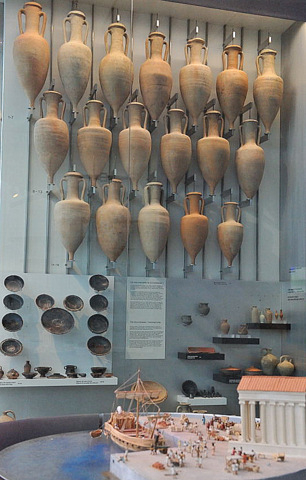 Opening Hours
Opening Hours
Summer hours: 15th April-15th October
Tuesday-Saturday 10am-9pm
Sundays and Festival days 10am -3pm
Closed Mondays, 1st and 6th January, 1st May, 24th, 25th and 31st December
On Saturday evenings there are free guided visits at 6.30pm ( in Spanish)
Winter hours :16th October-14th April
Tuesday-Saturday from 10am- 8pm
Sundays and national holidays from 10am-3pm
Closed Mondays
Entrance fee
3 euros, reduced fees 1.50 euros for groups of more than 5 people.
Free entry for under 18s and over 65s, plus disabled, unemployed, students, large families, tourism guides and personnel of any other museums.
Free Entry. Saturdays after 2pm, Sundays, 18th May, International Museums Day, 6th December and 18th April
Accessibility
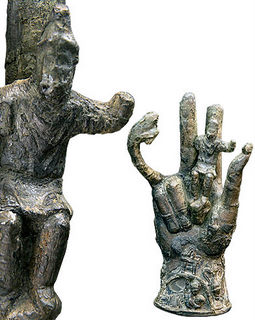 Entrance is via a long ramp, and internally the museum is optimized for disabled access.
Entrance is via a long ramp, and internally the museum is optimized for disabled access.
Extra Facilities.
There is a stylish cafeteria which has an enormous window looking out across the port area and is an excellent place from which to see the cruise ships when they are in port. The café serves a range of basic food and drinks.
Address and parking
Paseo del Muelle Alfonso XII
This is the main paseo area running along the waterfront. There is parking directly below the paseo in the underground carpark.
Tel: 968 12 11 66





































